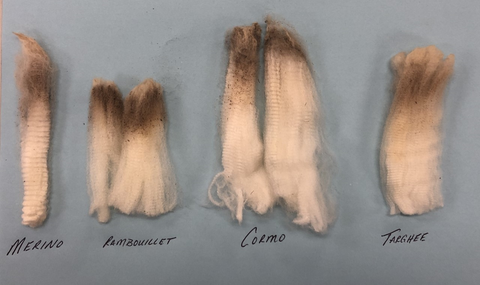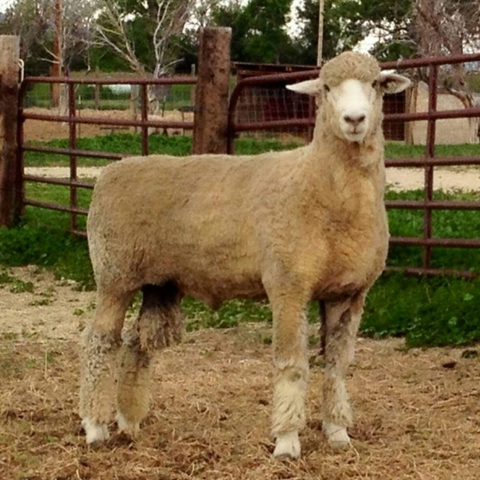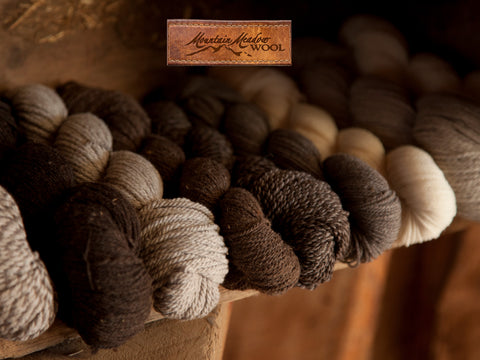Sheep Breeds: What do you know about Wool?
Sheep Breeds: What do you know about Wool?
Johnson County, Wyoming, like much of the rest of the state is largely rooted in the raising and rearing of sheep. Which as you know, and probably guessed, is an obvious reason why Mountain Meadow Wool Mill exists. While our mill is dedicated to serving our local producers, we are just as in tune with providing a custom wool processing for the world’s shepherds.
With that being said, today we will talk about some characteristics of wool based on sheep breeds.
It is estimated that there is over 1,000 separate breeds of sheep, let alone when we talk about crossbreds! In a generalization to provide you with more education, we will classify all of these sheep into three main categories: Fine wool, medium wool and coarse wool (longwool) breeds. In each category we will highlight the breeds that are most commonly ran through our mill.
Wool Category Background:
In America we have blood grades, there is also an English spinning count grade and of course a standard micron. We will use micron as our standard. A micron is a micrometer to show the average fiber diameter of an individual wool fiber. Fine wool breeds are typically anything under 17 microns up to 20.6022 microns. Medium wool breeds are typically from 22.05 – 29.3 microns. Coarse wool can be classed into 31 microns and up. 22-24 microns is technically in the medium wool category, but still create wonderful knit products.
Disclaimer: Before we get into breeds…. Of course, each sheep is different, and every breeder selects for different traits, so there is some variability in each breed.
Fine Wool Breeds:
Most common knowledge shows that the majority of fine wool sheep have lineage back to the Merino sheep breed. Merino, Rambouillet, Targhee and Cormo are the sheep we usually expect to find in this category. These come in an array of crimp and staple characteristics. Merino have a bold distinct crimp and an  extended staple, whereas the Rambouillet breed have many more crimps per inch and typically exhibit a shorter staple. A Cormo (Merino x Corriedale cross) has longer staple with a more similar crimp to that of a Merino. Targhee will most closely assimilate to a Rambouillet. When we start to work on custom wool products and processing, we use these breeds for their comfort factor. Because of this, next to skin applications are a common use for these breeds. Sweaters, blankets, throws, fine yarns, hats, gloves, socks, you name it, these sheep breeds make soft luxurious products.
extended staple, whereas the Rambouillet breed have many more crimps per inch and typically exhibit a shorter staple. A Cormo (Merino x Corriedale cross) has longer staple with a more similar crimp to that of a Merino. Targhee will most closely assimilate to a Rambouillet. When we start to work on custom wool products and processing, we use these breeds for their comfort factor. Because of this, next to skin applications are a common use for these breeds. Sweaters, blankets, throws, fine yarns, hats, gloves, socks, you name it, these sheep breeds make soft luxurious products.
Medium Wool Breeds:
According to New Mexico State University, a medium wool breed is a white-faced crossbred sheep. What we see here at Mountain Meadow Wool for medium breeds is usually the coarser side of the Targhee and Rambouillet breeds, but we also process a lot of Columbia and Corriedale sheep breeds as well. What makes these breeds a medium breed is the outcross of their original genetics and the fact that more often than not, there is some variation in fineness and crimp. Sure, while these are “coarser fibers” there is a still a level of comfort factor for these breeds. We find that outer layers and heavy type blankets are great for these breeds when they are on medium wool micron scale. The finer edge of this micron range provides enough softness while avoiding the prickle factor that comes with coarser fleeces. This means that a blanket, a heavy yarn for scarves, or a throw won’t be as itchy and scratchy as coarser fibers.
 When evaluating a Corriedale lock, you will see an extended staple length and a bold almost Crinkle Cut-French fry appearing crimp. We think that the uniqueness of the Corriedale staple, coupled with the strength of that breeds fleece that we can utilize our custom wool processing to create long lasting products. If you check out the picture right here, you see a Columbia Ram that was raised here in Buffalo! The Columbia sheep breed has a large degree of variation in its character of locks and fineness of grade. They can have crimp similar to a Targhee and Rambouillet, but also have bolder crimp or even less breed character. Originally this breed was as ½ blood, a Lincoln Rambouillet cross, which is why they have medium wool. The Rambouillet was selected and bred into them for their fineness of grade and the Lincoln for its body size and staple lengths. A few people in our mill are partial to the breed because it was first bred in Laramie, WY. As a Wyoming mill, we are always excited to process the wool from our home state breed.
When evaluating a Corriedale lock, you will see an extended staple length and a bold almost Crinkle Cut-French fry appearing crimp. We think that the uniqueness of the Corriedale staple, coupled with the strength of that breeds fleece that we can utilize our custom wool processing to create long lasting products. If you check out the picture right here, you see a Columbia Ram that was raised here in Buffalo! The Columbia sheep breed has a large degree of variation in its character of locks and fineness of grade. They can have crimp similar to a Targhee and Rambouillet, but also have bolder crimp or even less breed character. Originally this breed was as ½ blood, a Lincoln Rambouillet cross, which is why they have medium wool. The Rambouillet was selected and bred into them for their fineness of grade and the Lincoln for its body size and staple lengths. A few people in our mill are partial to the breed because it was first bred in Laramie, WY. As a Wyoming mill, we are always excited to process the wool from our home state breed.
All in all, medium wool sheep breeds create versatile products. They are long lasting, stronger fibers that still have enough comfort factor to remain soft. They blend with finer wool fibers greatly to add some extra endurance to those finer fleeces without sacrificing the luxury and comfort of those nice next to skin type fleeces.
Coarse Wool Breeds:
Coarse wool sheep and longwool sheep breeds can be some of the most fun for hand spinners and knitters. Think back to Grandpa’s scratchy, itchy, terrible old wool blanket that he had when he was ten. They caused rashes and the prickle of them alone could leave one dreading wool. But, thankfully as time has progressed, so have we in the sheep industry. We have found new uses for this type of yarn that creates products that hold superior durability.
Wool rugs, table runners, saddle blankets, insulation, car floors, heat pads, you name it, coarse wool breeds have done it. Here at Mountain Meadow Wool, when we take wool in for custom processing, we figure out the fineness of the fleece and work with our customers to create the best end product for them. Our table runners, heavy weight yarns and saddle blankets often provide the best use of coarser wool for our customers. These heavy weight yarns are superb for outer layer clothing and for rug type uses. Our hand spinners and weavers love the coarser heavier weight yarns because of how strong these fibers are and just like medium wool breeds the versatility. From outer layer clothes to a product on the kitchen table, there is a lot of neat things happening with coarse and long wool breeds.
 Some breeds we often see here at MMW are Lincoln, Icelandic, Cheviot, Southdown, Navajo Churro, Suffolk, numerous crossbreds, Dorset and the list goes on. These coarse, longwool, and meat-type breeds are popular for numerous reasons. We here at Mountain Meadow Wool are happy that our custom wool processing can provide a place for these breeds to have an opportunity for their wool to shine. Speaking of shine, that is another reason longwool breeds like Lincoln, Icelandic, etc. are popular. The luster of these fibers provides an unmatched shine in their final products.
Some breeds we often see here at MMW are Lincoln, Icelandic, Cheviot, Southdown, Navajo Churro, Suffolk, numerous crossbreds, Dorset and the list goes on. These coarse, longwool, and meat-type breeds are popular for numerous reasons. We here at Mountain Meadow Wool are happy that our custom wool processing can provide a place for these breeds to have an opportunity for their wool to shine. Speaking of shine, that is another reason longwool breeds like Lincoln, Icelandic, etc. are popular. The luster of these fibers provides an unmatched shine in their final products.
Like we said in the beginning, there are 1,000’s of breeds, and if you raise a breed that we did not mention, or have a questions about the character, crimp or fineness of the sheep you raise, feel free to contact us with any questions regarding a custom processing of your wool. Do not hesitate to contact us about what products we make and would best fit your wool clip.
We offer this service to you, because we know the difference that a value-added program can be to an operation. Here at Mountain Meadow Wool Mill, our custom wool processing stretches across hundreds of sheep breeds. We are here to create a lasting product from your wool clip that both you as a producer and us as a mill will be proud of.






Hi thank you for this article.
Im a spinner in the uk and found this to be very helful and informative, rambuouillet is gorgeous and fast becomeing my favourite spin.
I can tell that your website is incredibly educational, and each post is superior to the blog and articles on any other website. There is more information on your blog than any other. You are undoubtedly one of the most informative article writers, in my opinion. Somehow, I came onto another educational blog with similar content to yours. You can visit the websites farmingplan.com to learn more about farming.
Great article Thanks for sharing.
Hi I was wonding if you know of someone who could help me learn stuff about wool. And I will be 8n lost spings for a few day not sure when so if you could help me out that would be great . My sister and her soon to be husband have sheep but I want to find out the grade and what we can do to make the wool better stronger just with food.
Thank you for this information about sheep breeds. This was enjoyable to read. I truly appreciate the work you do , the knowledge you have and that you are preserving a way of life for people and animals .
Leave a comment